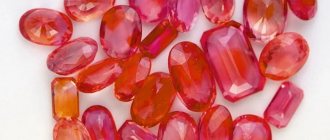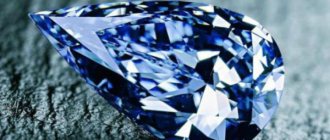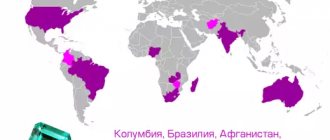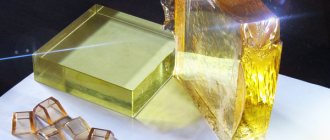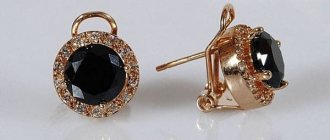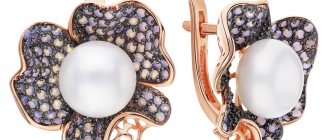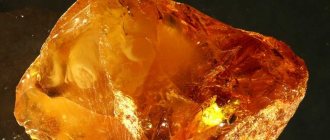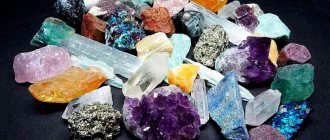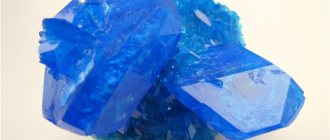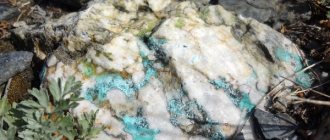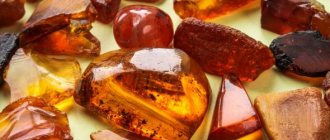Chiastolite is a mysterious mineral that is surrounded by true stories and legends, scientific sensations and sacred rituals. Even the process of stone formation remains a mystery; there are only assumptions.
For thousands of years, the mineral was used in many cultures as a talisman, and until the end of the 16th century it embodied devotion to God for pilgrims of the Way of St. James.
Origin. Story
The first scientific description of chiastolite was made by the German scientist D. Karsten in 1800 .
It was found that its origin is metamorphic. Formation occurs in clayey or carbonaceous rocks rich in aluminum: prismatic crystals of andalusite, which grow in parallel and in groups of four, are connected by a cementing substance. The name of the stone comes from the Greek word “kiastos”, which translates as “marked with a cross”. Other names for this mineral:
- crushes;
- maltesite;
- cross;
- cross stone;
- sacrum.
In medieval lapidaries (books on metals) it is referred to as lapis crucifer (crucifix stone) and is described as a means that can ward off evil spirits.
People in different parts of the world have been familiar with this mineral for a long time; for example, the warlike Celts considered it the focus of a powerful force, similar to a lightning strike. Therefore, chiastolite was sometimes called:
- lightning stone;
- Celt;
- Celtic stone.
The Indians created their own legendary history of chiastolite. They made the “stone with a cross” an amulet against dark forces. During the Spanish Conquest, this mineral embodied the souls of Indian warriors who gave their lives for their land in battles with the invaders.
With the beginning of the Christian era, the importance of chiastolite for humans increased. The first adherents of this religion made it their amulet and considered it a sign of divine love and forgiveness. Each participant in the Crusades for the Holy Sepulcher had with him a body amulet made of chiastolite. The Knights Templar wore rings only with this stone and believed that it would protect them in battle. It also became popular among alchemists, philosophers, soothsayers, soothsayers, for example, Nostradamus had a chiastolite rosary, a ring and a large pendant.
Chemical composition
The silicates group includes many different stones. Only a few are considered precious. This precious mineral is a derivative form, a separate variety of andalusite. It is dominated by aluminum, silicon and oxygen, the formula is as follows: Al2(SiO4)O. In structure, these are crystals fused in a special way, with graphite and clay inside, which pierce it diagonally from the center, creating a beautiful pattern: a black cross on a coffee background. Sometimes the overall background is dominated by red, yellow, white, green shades - visually the stones can differ quite greatly from each other. The color is determined by the amount of manganese in the composition. The hardness of this mineral on the MOSS scale is 5.5 units, that is, it is relatively soft and its surface needs additional protection.
Description
Chiastolite is agglomerates, quite large, opaque, with a glassy sheen. The most common specimens are red-brown, yellowish-brown, and gray, but sometimes they are green, white, and pink.
The main feature by which chiastolite can be identified is several dark intersecting stripes. Such a cross appears more clearly on the cut of the stone. It can be seen from any side, at different angles.
If the clay-graphite component predominates in the crystal, triangles may appear at the ends of the cross and it becomes similar to a Maltese cross.
Physico-chemical characteristics of chiastolite
Chiastolite crystals grow together from four parts, between which there is clay and graphite rock.
A cross section of such a fusion clearly shows a black cross with rays expanding from the center to the edges. The dark cross stands out against the light background. By its chemical nature, chiastolite belongs to aluminosilicates; it is opaque, has a low shine, like a glass surface, weak luminescence and high optical performance. Hardness on the Mohs scale 7.5. Columnar or cubic crystals consist of a granular structure with impurities.
Place of Birth
Chiastolite is commonly found in metamorphic rocks, where it is often combined with kyanite and corundum. But it is also found in igneous rocks, such as granite.
Deposits of the mineral are dispersed in different parts of the world. The raw material standards are different:
- In Andalusia (Spain) stones with pleochroism are mined.
- In Italy, pink, red-brown, light gray with a greenish tint are found.
- Howdenites (pairwise fused crystals) are supplied to the world market from Australia The name comes from Mount Howden, where these small stones ( up to 4 cm ) are mined. They have a pattern in the form of imprints of fern leaves.
- In the USA, brownish-red, brown, yellow specimens with a diagonal cross (as on the St. Andrew's flag) are mined.
- In Russia, deposits of the mineral are located in Transbaikalia, where red-brown stones are extracted, and in the Urals, in the Ilmen Mountains, where large samples ( up to 10–11 cm ) are mined.
The following countries also mine chiastolite:
- Canada;
- Brazil;
- Chile;
- Germany;
- France;
- China;
- Sri Lanka;
- Myanmar.
Read also : Black agate is a protective that guides you on the path of good
Application
Chiastolite is considered a jewelry-ornamental (that is, semi-precious) stone. With the advent of Christianity, it became a material for body crosses, icons, rosaries, and amulets. Beads are turned from the stone or processed into a cabochon, then rosaries and pendants are made. The frames are usually made in the simplest way.
For the manufacture of secular jewelry, bright samples are used, and white gold or silver is used for the frame. Ring inserts are usually made from high-quality specimens that are faceted.
Earrings, rings, and pendants are also made from chiastolite. Jewelry craftsmen especially value rare specimens up to 4 cm , in which the pattern resembles a fern leaf. Instances with a translucent cross on a brown background also look elegant.
Processing crystals is not easy, as they are quite fragile and have an uneven surface. To eliminate cracks, the surface has to be glued. In order to improve its presentation, the stone is boiled in paraffin and glycerin. This makes it more transparent.
A popular interior item is a chiastolite ball on a stand.
White specimens of this mineral with a clear black cross are in demand among collectors.
Colors and shades of stone
Chiastolite has many colors and shades. The most common is brown with a dark pattern. The following shades of the mineral are also often found:
- white;
- grey;
- yellow;
- orange;
- green;
- red
All colors are in demand among jewelers and are suitable for making jewelry. You can also see a rare golden-colored gem. Whatever the main shade of the chiastolite, the cross against its background will always be black.
An amazing property of chiastolite is its ability to change color under different lighting conditions. This is called pleochroism.
Medicinal properties
For a long time, chiastolite has been considered a protective stone against diseases and negative emotions. It strengthens the nerves, heals the soul, and lifts the mood. It is useful for people prone to depression to contemplate this mineral to restore mental balance.
Chiastolite is able to relieve chronic fatigue and transform negative energy into positive. This is due to the fact that the vibrations of the gem are friendly to humans.
If you take the chiastolite in your hand, close your eyes, focusing on your palm, then after a while you can feel the flow of energy. Then calm will follow and your mood will improve.
It is especially useful for nervous, hot-tempered children and teenagers to wear the mineral, as it relieves fear and mood swings.
Healers advise people suffering from long-term illnesses to wear chiastolite, as it can instill hope for recovery.
Attention! It is permissible to treat diseases with the help of a stone only in combination with medications and procedures prescribed by a doctor.
Medicinal value of chiastolite for humans:
- Increases overall vitality and strengthens the immune system.
- Normalizes hormonal imbalance, metabolism, helps absorb nutrients, remove toxins and waste.
- Helps restore bones and connective tissue (in this case, you need to place the stone on the body).
- Good for joints: restores mobility to limbs, treats rheumatism, gout.
- Helps cure colds and diseases of the respiratory system.
- Can help improve heart function.
- Helps in treating skin from burns, rashes, and wounds.
The healing properties of unprocessed samples of the mineral are more pronounced.
Stone upon stone, or a few words about urolithiasis.
Stone upon stone, or a few words about urolithiasis.
In Russia, more than 1 million people are currently registered as suffering from urolithiasis. In total, there are about 3% of patients in the world. The Nizhny Novgorod region is one of the disadvantaged regions for this disease, so the problem is urgent for us. What to do to prevent a “diamond mine” from forming in the kidneys, and what should those who do have the misfortune of “acquainting themselves” with renal colic do? Vera Alekseevna Ladygina, a urologist at the Clinical Diagnostic Center, will talk about this.
Hello, Vera Alekseevna, why do stones form in the kidneys?
There is still no consensus in the medical community on what exactly causes urolithiasis. After all, both kidneys secrete urine. But why then do stones form in one kidney and not in the other? And the composition of the urine passing through both kidneys is the same. Therefore, doctors say that urolithiasis is a disease that is manifested by increased excretion of mineral salts in the urine and the formation of stones in the urinary tract. But how this happens - there are many opinions about this, but there is still no complete and unambiguous answer to this question.
Who is more susceptible to this disease? Who is at risk?
Naturally, these are people with kidney diseases - acquired or hereditary, for example, kidney anomalies, horseshoe kidney, etc. In healthy kidneys, stones never form. Urinary tract infections and urinary tract abnormalities contribute to increased crystallization of salts in the urine. After all, urine is a saline solution, but the salts are dissolved in it, and through healthy kidneys these salts come out along with the urine, and when there are some diseases, the crystals precipitate and grow into stones. It is still not clear why these crystals linger in the kidneys, because nothing prevents them from leaving while they are still small. There may be a small stone in one kidney and a large one in the other. So the process of stone formation itself has not yet been sufficiently studied.
Does a person’s age affect the formation of stones?
Stones can form even in newborns. Moreover, they are large, and they have to be crushed immediately. This indicates that the child has a congenital disease of the genitourinary organs.
Who suffers more often from stones? Men or women?
Men. This is due to the fact that women have the hormone estrogen, which prevents crystals from sticking together into stones. I repeat, if the kidneys are healthy, stones will never form.
How does urolithiasis manifest itself?
Pain in the abdomen and lower back is an essential component of urolithiasis. There are people who are patient and do not pay attention to pain for a long time. As a result, doctors discover large stones. People don’t go to the doctor for a long time because a large stone behaves more or less calmly, sometimes giving a dull, aching pain. A small stone gives severe sharp pain in the form of renal colic. Well, the second main sign is blood in the urine. As a rule, there can be a lot of it, and the patient sees it “by eye,” which indicates that the stone is moving. The disease is diagnosed by ultrasound and based on the results of urine tests, the composition of the salts in the urine can already be used to predict the composition of the stone.
What kind of stones do Nizhny Novgorod residents have?
In our region, as in general and throughout the country, oxalates predominate (up to 75%). In second place are phosphate stones (up to 15%), then urate stones (2-7%) and cystine stones - up to 3%. They differ in composition.
How can you alleviate your condition during renal colic?
There is a good and safe medicine - Urolesan, consisting only of herbs. For patients with urolithiasis, it is always at hand. Taking this medicine will relieve the pain of renal colic, if the attack that happened is just that. This is the only thing the patient can do before the doctor arrives. The main thing is to consult a doctor immediately; prolonged presence of a kidney stone is fraught with purulent inflammation and loss of the organ.
That is, advice from the Internet - lie in a hot bath and take No-shpu - is this bad advice?
Undoubtedly. No hot bath or painkillers, because you yourself will not be able to determine the cause of the pain. What if you don’t have renal colic, but an attack of acute appendicitis? What if a woman has an ectopic pregnancy? In medical terminology, there is the concept of “acute abdomen” - this is a condition in acute appendicitis, acute cholecystitis, intestinal colic, ectopic pregnancy... In this condition, the clock counts for making a diagnosis before surgery. Pain in renal colic and in these dangerous conditions can easily be confused, so you should never engage in self-diagnosis or self-medication. Urolesan didn’t help, which means you don’t have renal colic. Let the doctor figure it out; renal colic, unlike the other above-mentioned conditions, can be observed for three days to make a diagnosis and make further decisions on treatment or surgery.
By the way, about operations. People who have not encountered the problem say that the stones are somehow “crushed.” Others say they are being operated on. Tell us what treatment methods are currently used.
Nowadays, abdominal operations are performed only when absolutely necessary. Surgical treatment has become more comfortable. Basically, minimally invasive endoscopic operations are used, when a stone is removed through a puncture in the lumbar region, or crushed by applying electrodes to it, again, through a puncture, or through the urinary tract. There is also a non-surgical method of crushing stones - lithotripsy, when a special device is aimed at the kidney area at the stone and, with the help of short pulses of energy, destroys it step by step until small particles remain from the stone, which themselves are excreted in the urine. The doctor chooses the methods himself. It happens that drug treatment is enough. And so, they split it up, observed it for two or three days, and went home. There are practically no complications when crushing stones.
If the stone is removed, can you continue to live in peace?
Unfortunately, no, with urolithiasis the likelihood of relapse is extremely high. No matter how effectively the operation is performed, it will not be possible to do without complex and individually selected drug therapy. Patients should be observed after surgery by a urologist for several years.
What should you drink and eat to avoid any stones?
A healthy person needs to drink 2-2.5 liters of fluid per day, preferably plain water. I'll explain why. Plain water does not cause digestion in the stomach. Like a shower, it passes through the entire body, internal organs, including the kidneys, washes them and leaves. If we drink other liquids - juice, compote, tea, coffee - the stomach begins to work, gastric juice, hydrochloric acid, enzymes, etc. are released. If you have been diagnosed with urolithiasis, drink 3-3.5 liters of water per day. As for taking vitamins, for example, calcium, everything should be in moderation. The diet should be rich in fiber. It is advisable to consume a lot of plant foods. Fiber, or dietary fiber, is useful in that it absorbs a lot of water and swells, stretching the stomach and preventing overeating, because. the stomach considers itself more “full”, this is a plus. The second advantage is that then this swollen lump of food, rich in fiber, cleanses the digestive tract without leaving solid mineral substances on the walls - the same ones that, being absorbed into the blood, then enter the kidneys and form crystals. Meat and fish should only be limited if you have uric acid stones. For other types of stones, these foods can be eaten.
Returning to the issue of water. Our region has very hard water. Does this affect the health of Nizhny Novgorod residents?
The Volga region is indeed an unfavorable region for urolithiasis due to increased water hardness. Water must be boiled before use. But, most importantly, take care of your own health. I repeat, if your kidneys are healthy, there is nothing to be afraid of.
In addition to drinking the right amount of water and proper nutrition, it is important to avoid prolonged stressful situations, stress provokes the formation of stones. Need more rest. Physical activity is important. And then you will not face urolithiasis.
Interviewed by Danila Rezak.
What foods to look for fiber in?
These are wheat bran, bread (rye flour, Borodino, whole grain flour), porridge (buckwheat, pearl barley, oatmeal, wheat), nuts (almonds, pistachios, hazelnuts and walnuts), mushrooms, legumes (green beans, peas, lentils ). Vegetables: cabbage (Brussels sprouts, cabbage), carrots, beets, zucchini, pumpkin, tomatoes. There is also a lot of fiber in greens - parsley, dill, lettuce, green onions. And also in fruits, dried fruits and berries - such as black currants, dried apricots, dried apples, raisins, prunes, pears, oranges, bananas, apricots, raspberries, strawberries and others.
The champions in fiber content are: wheat bran, dried apricots, black currants, dried apples and raisins.
Important: The operation for remote crushing of stones (extracorporeal lithotripsy) is carried out free of charge within the framework of the “Program of state guarantees of free provision of medical care to the population of the Nizhny Novgorod region for 2016.” In particular, remote lithotripsy according to compulsory medical insurance is performed at the State Budgetary Healthcare Institution "City Clinical Hospital 13 of Nizhny Novgorod". You can find out where else such operations are carried out under compulsory medical insurance by contacting the Territorial Health Insurance Fund of the Nizhny Novgorod Region.
Article provided by the advertising and information weekly 'Arena'.
Magic properties
Because of its unique design, chiastolite has been perceived since ancient times as a mystically strong stone. Its magical properties were used in various rituals, for example, when expelling evil spirits. With its help, sorcerers tried to “read” the past and get in touch with other worlds. To do this, they intently contemplated the pattern or placed a stone on the area of the “third eye.”
Christians attach special importance to the metaphysical properties of chiastolite. They are sure that this stone testifies to the glory of God, His all-forgiving love for people. It is believed that the gem strengthens faith, helps to rely on it in difficult moments, hoping for the best.
This mineral helps to extract secret, hidden information from space. Therefore, it is suitable for those who work with ordinary secret information or sacred information.
Modern esotericists have identified the following magical properties of chiastolite:
- Helps you concentrate to solve problems, think clearly, make the right decisions, and act rationally.
- Relieves the oppressive feeling of guilt.
- Brings inner harmony and tranquility.
- It is a strong home talisman against natural disasters, damage, envy, and gossip.
- Helps creative individuals believe in themselves. It simultaneously stimulates creativity and practicality, which helps people who want their work to be understood and appreciated.
It has been noted that chiastolite is an effective talisman and amulet only for friendly people, while owners with bad intentions quickly lose the mineral.
Rules of care
It is necessary to take care of chiastolite regularly. The gem attracts all negative energy. That is why it is recommended to rinse it regularly under running water (it would be better to use spring water).
The liquid pressure should be small. It is important that the jet does not hit the stone. Afterwards you need to lay it on a soft cloth and wait until it dries completely, putting it in a dark place. After cleansing, chiastolite can be used again.
Chiastolite is a unique stone that has a dark cross on a light background. In history, many legends, superstitions, and predictions are associated with the mineral. It was valued and used by the Indians and Celts in Europe. To this day, people believe in the unique healing and magical properties of chiastolite.
Who is suitable according to their zodiac sign?
Chiastolite can be worn by all people, regardless of what constellation they were born under, but it shows special friendliness to Libra, Pisces, and Gemini.
Since this stone has the ability to bring harmony, it is best suited for Libra. People of this sign especially need it. The mineral can help achieve spiritual harmony, drive away disappointment and fatigue. In addition, it will strengthen intuition and make a person wiser.
Some astrologers believe that chiastolite is ideal for Taurus. It helps this sign strengthen analytical skills, which is useful for solving various problems.
It must be remembered that the stone does not help those who wish harm to other people.
Read also : Scapolite - a stone staff that bestows knowledge
Chiastolite in astrology
Chiastolite patronizes Pisces, Libra and Gemini. But they use it only for spiritual development and solving internal problems, calming down. If the goals are mercantile or harm others, the stone will not help.
- The problem with Aries is lack of restraint and excessive emotionality. The stone will reduce negative qualities, make you cautious and circumspect in words and actions. He especially favors women. It improves well-being and brings harmony to the family.
- Taurus is a picky and dissatisfied zodiac sign. This prevents him from living to the fullest and enjoying everything that happens. Chiastolite will make Taurus positive, improve mood and soften character.
- For Gemini, chiastolite will improve health and enhance spirituality. It will also enhance attentiveness, observation, intuition and insight, which will simplify life and open up new opportunities.
- Cancers are thorough and do not like spontaneity. In this regard, they may have a conflict with andalusite, which changes color with each rotation of the stone. In addition, the mineral gives the owner intuition, and vague premonitions and insights can unsettle Cancer.
- Leos, despite their apparent firmness and determination, are often insecure because they depend on public opinion. The mineral will help strengthen faith in oneself and one’s strengths, which will help the zodiac sign to realize itself and receive great inner satisfaction from this.
- For a virgin, chiastolite will become not just a talisman, but an assistant in all difficult and confusing life situations. It will strengthen your intuition, which will help you avoid mistakes and problems.
- The mineral will make the life of Libra calm and harmonious. It will save you from unnecessary worries and losses. Women will feel the special placement of the stone. They will be able to improve their personal life by starting new relationships or strengthening old ones.
- Scorpios should wear andalusite stone with caution. Under its influence, one can lose control over oneself, relax and, in critical situations, stop making informed decisions.
- For Sagittarius, chiastolite will be a prophetic stone that will indicate future problems in life. During these periods, it will strengthen the owner’s spirit and give him strength so that he can overcome obstacles with honor.
- Self-realization is important for Capricorn. Chiastolite will help you find your path and goal, strengthen the emotional connection with family and friends, and make coldish Capricorns more sensitive.
- For the zodiac sign Aquarius, andalusite will be an ideal amulet. They are energetically similar in their desire to live in harmony with nature and adapt to it.
- Pisces are soft, pliable, and doubt everything, so they should not use chiastolite. This will further strengthen their mental tossing and doubts.
I would like to believe that beautiful and strong stones are capable of changing the world for the better, eradicating evil. Perhaps under his influence there will be more spiritual people with pure thoughts who strive for truth and justice.
How to care
Although chiastolite is quite fragile, caring for it is easy:
- Try not to drop it, protect it from impacts so that cracks or chips do not appear.
- Wash off dirt with running water at room temperature; if necessary, use baby or other neutral soap.
- Protect from low and high temperatures, keep the stone away from heating devices.
- Remember that when exposed to bright sunlight, the mineral may turn pale.
To recharge your chiastolite energetically, place it under the light of the full Moon. If you suspect that you have been magically influenced, cleanse the stone of negative energy by leaving it on the windowsill during the new moon.
How to distinguish a real chiastolite from a fake
Counterfeits of chiastolite are made on the basis of chrysoberyl, smoky quartz and tourmaline, which are very similar in appearance. The main difference remains the cross-shaped pattern of the chiastolite, which cannot be imitated. The cross in natural chiastolite is located inside the stone and does not change in any way from any viewing angle and in any light.
Price
Products made from chiastolite are not mass-produced, so the cost of handicraft creations is quite high. Examples of prices for some products:
- A pendant (20x30x10 mm) without frame can be purchased for 1300 rubles .
- A bracelet made of beads (8–12 mm) costs 9,500 rubles .
- Ring in a frame with brass plating - RUB 1,500 .
- Ball (33–36 mm) — 1130–5100 rub .
Read also : Rock crystal - a stone of transparent purity
Decorations
The mineral is polished. But first it is cut into flat oval-shaped plates. It is also possible to make a cabochon. The resulting surface represents the symbol of a crusader. Stones are inserted into earrings, rings and pendants.
The frame is silver or white gold. Beads are used to make bracelets, necklaces, and rosaries. The cost depends on the quality and size. The pendant is valued at 1,300 rubles. The price of beads reaches 18,000.

